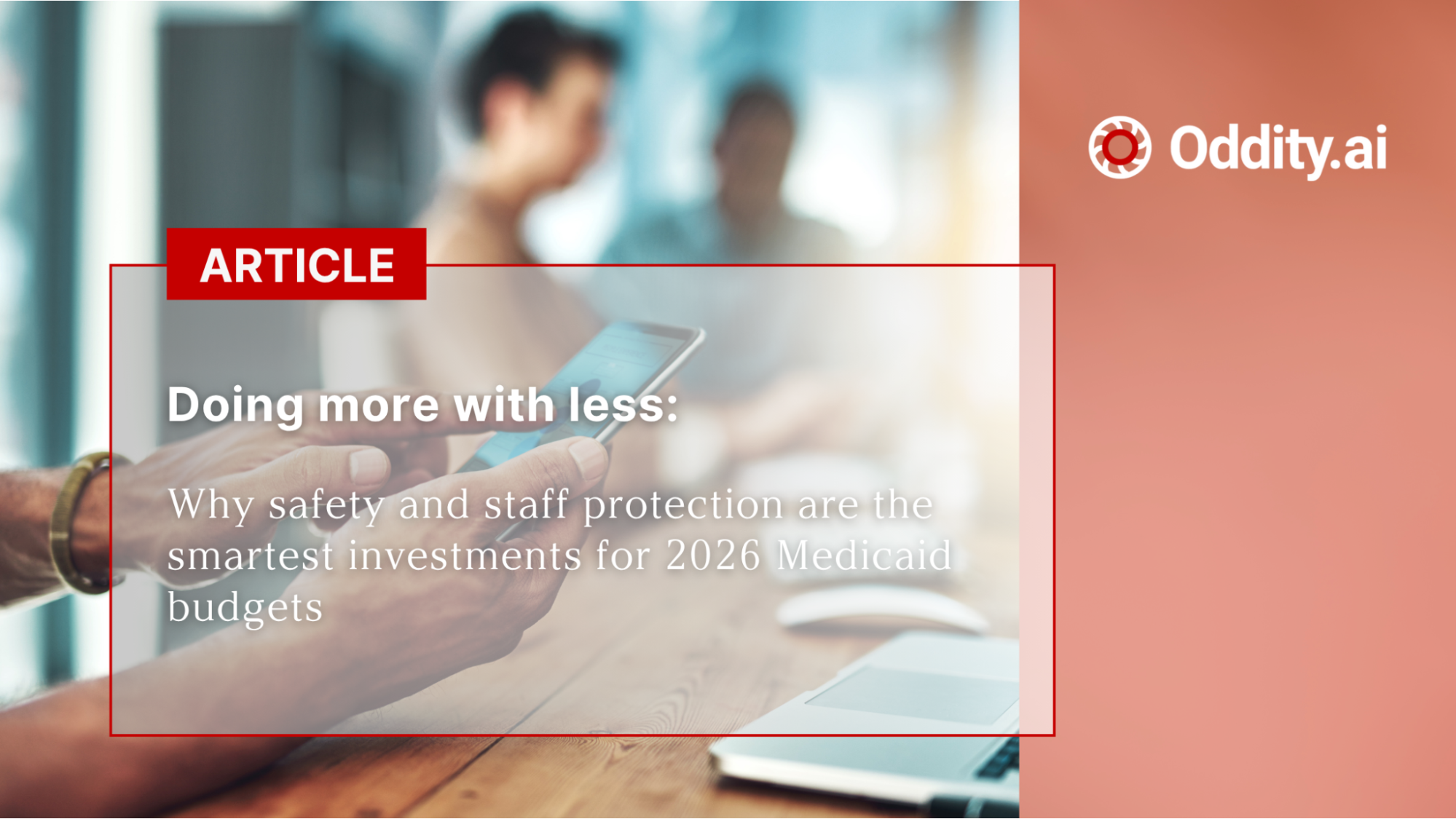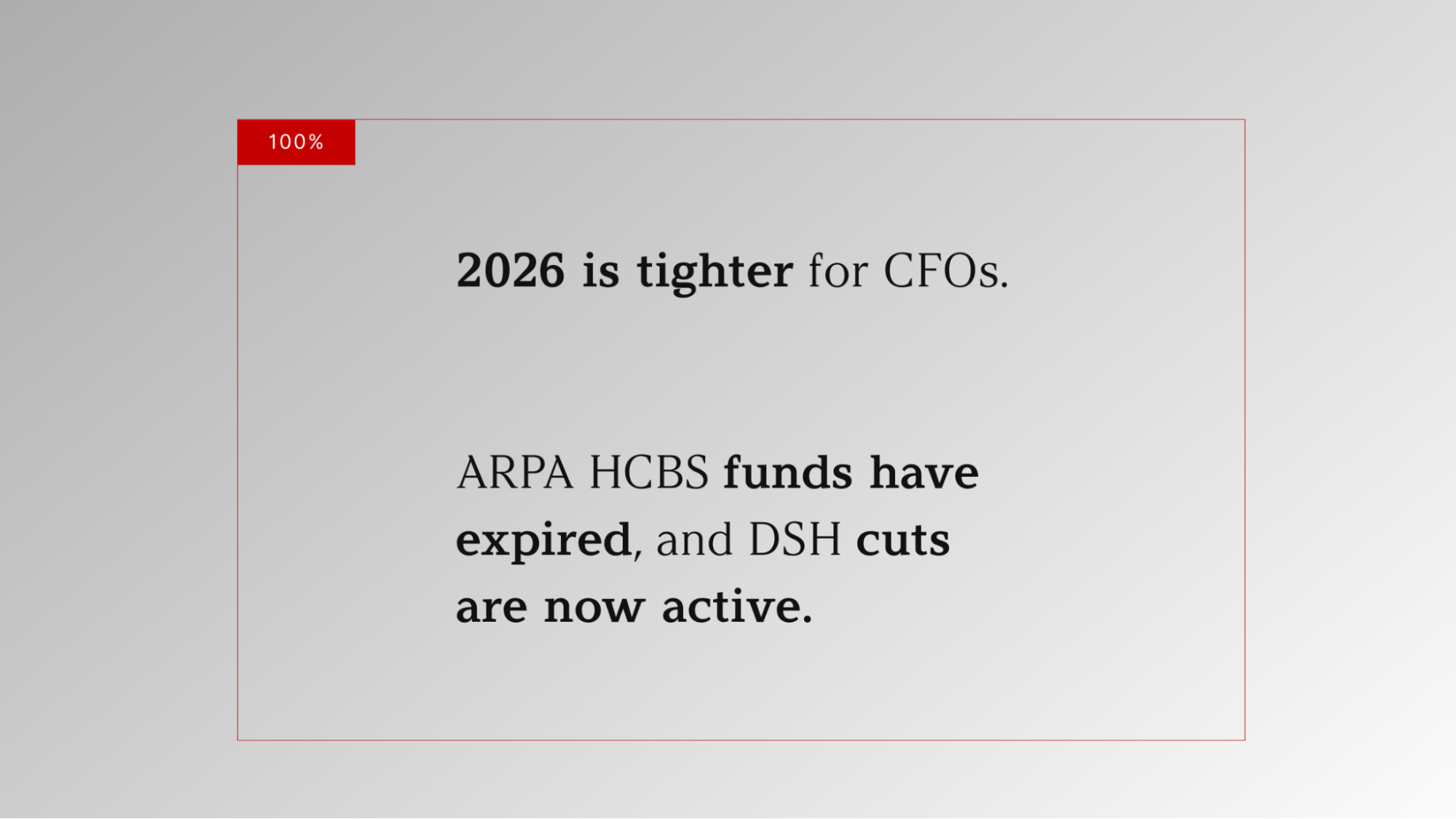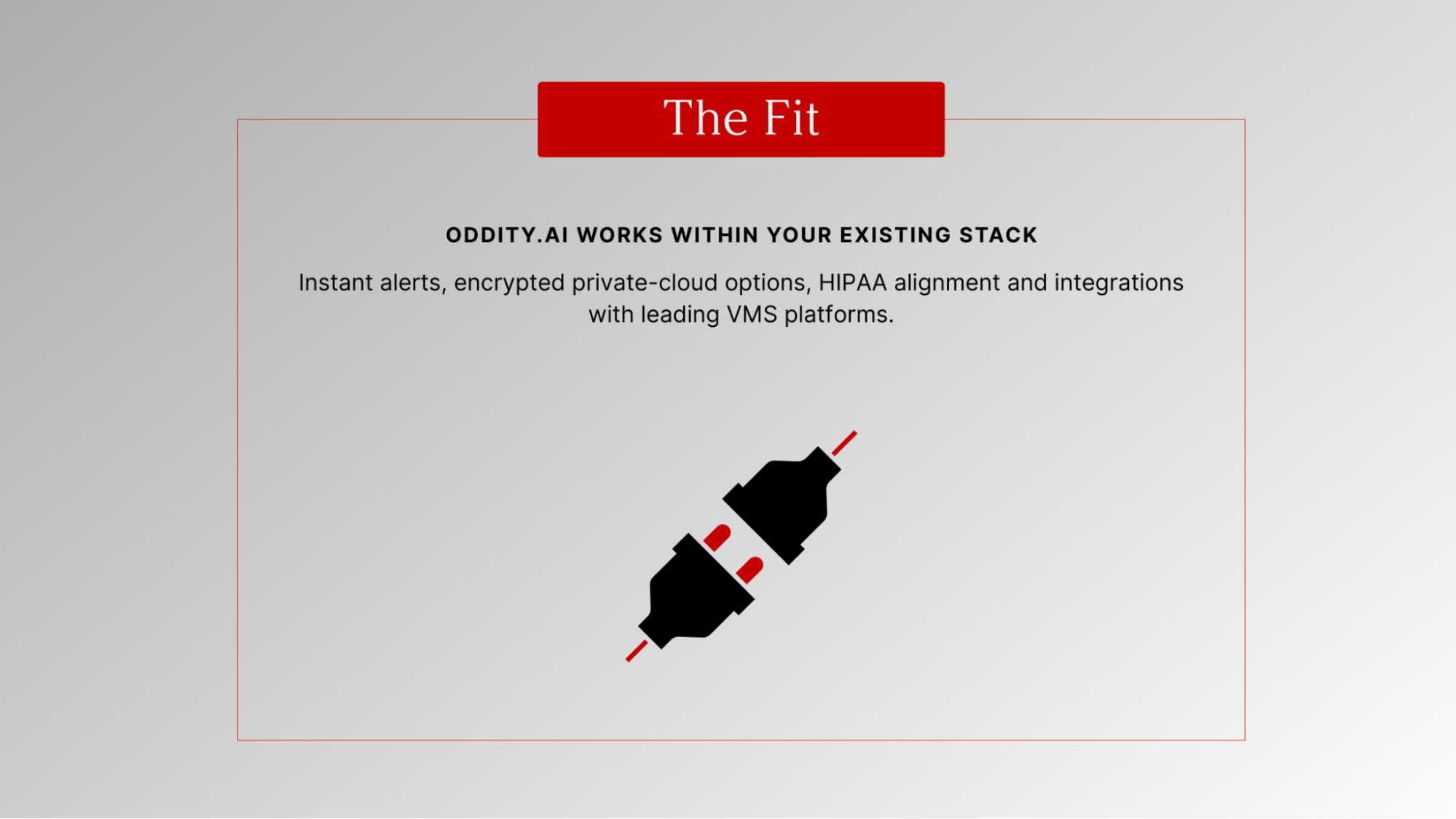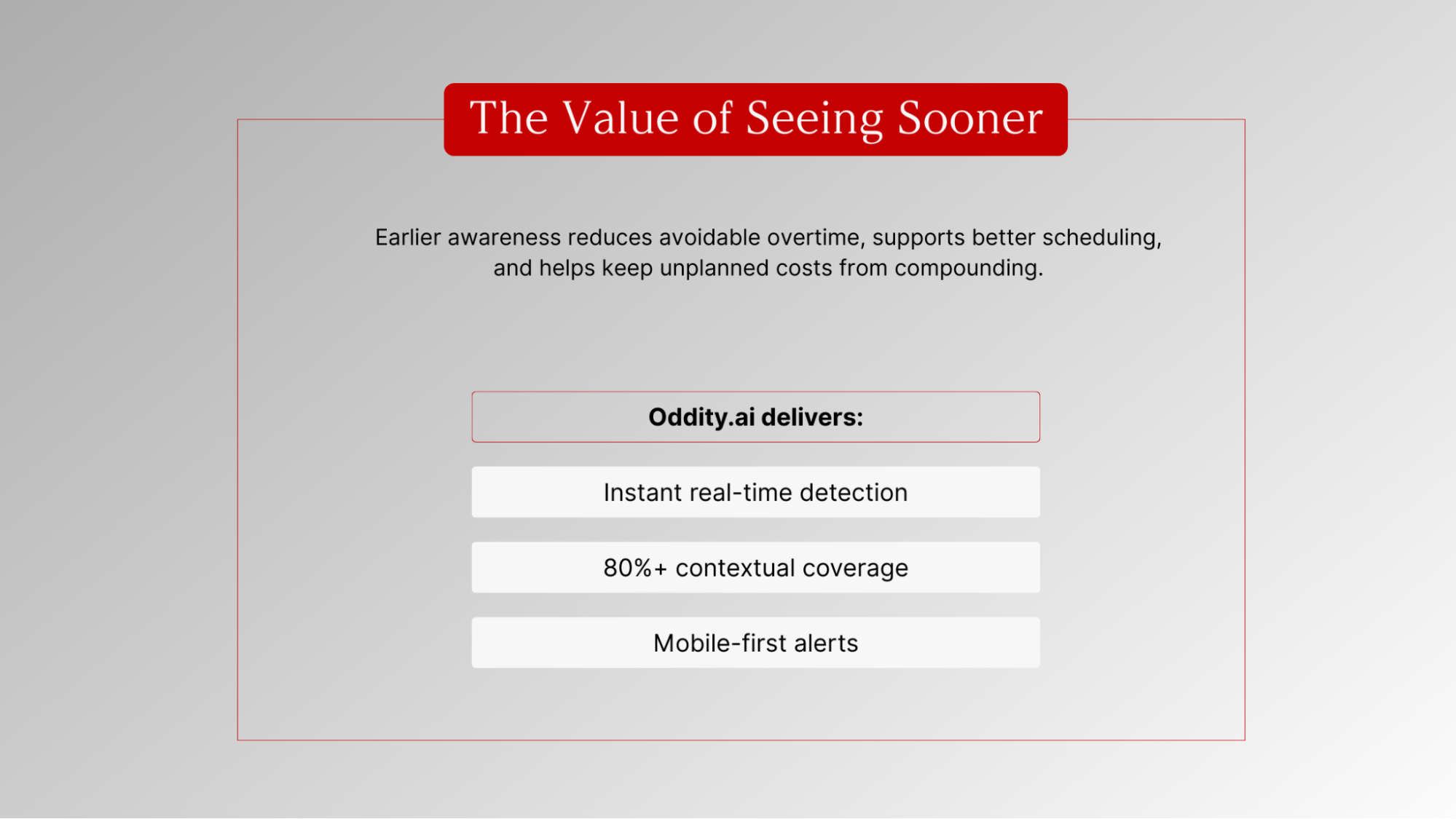
The end of 2025 brings tougher choices
As 2025 draws to a close, the healthcare sector faces a perfect storm. Staff shortages persist, payer volatility continues, and the fiscal cushions of pandemic-era funding are ending. For CEOs and CFOs leading Medicaid-dependent care organisations, the challenge is sharper than ever: how to safeguard both people and financial stability amid shrinking flexibility.
The 2026 Medicaid budget cycle will test every assumption about operational efficiency. With the ARPA HCBS funding sunset, the HCBS Access Rule’s 80 percent requirement, and DSH cuts 2026 coming into play, care leaders are left with fewer levers to pull. In this environment, the smartest investment isn’t in expansion. It’s in prevention: preventing incidents, preventing burnout, preventing turnover.
Your 2026 budget loves fewer incidents without adding extra headcounts. This is where evidence-driven, privacy-secure AI systems such as Oddity.ai’s real-time detection technology can make an immediate difference, helping leaders act within seconds, not minutes.
The Medicaid 2026 reality

The new fiscal year begins under the weight of several major policy shifts:
- ARPA HCBS funding sunset: Under the American Rescue Plan Act of 2021 § 9817, states received a temporary 10-percentage-point increase in FMAP for certain HCBS expenditures (April 2021–March 2022) and were required to expend those funds by March 31, 2025. (CMS overview)
- HCBS Access Rule: 80 percent compensation requirement: The CMS final rule (May 2024) requires that at least 80% of Medicaid payments for specified HCBS services go to direct-care compensation. (CMS fact sheet)
- DSH cuts 2026: Disproportionate-Share Hospital reductions took effect Oct 1, 2025 (FY 2026), tightening margins for safety-net providers.
- Payer-mix volatility: Coverage redeterminations and enrolment churn continue to destabilise revenues.
For leadership, these shifts redefine what “efficiency” means. Every dollar not spent on staff injury, overtime, or turnover is a dollar that can remain compliant with the 80% direct-care threshold while protecting frontline workers and the people they support.
Organisations using automated incident-detection platforms such as Oddity.ai have found that faster visibility over risk situations supports both operational reporting and compliance tracking, two growing pressure points for 2026.
The workforce challenge isn’t going away
The direct-care workforce remains under intense pressure. Vacancies and turnover persist despite wage increases. The result: thinner staffing ratios and heavier workloads.
- PHI National reports annual turnover above 60% in some home-care settings (PHI, 2024).
- Overtime, agency staffing, and absenteeism inflate hidden costs.
- Burnout drives retention loss, and each lost worker brings meaningful hard costs to recruit, onboard, and backfill.
In a tight Medicaid 2026 budget environment, these are not just HR metrics, they are financial-risk indicators.

Real-time safety intelligence, like Oddity.ai’s early-detection alerts that identify episodes of physical risk immediately, helps teams intervene sooner, protect staff wellbeing, and prevent cascading costs before they start.
Safety as a financial strategy
For too long, staff protection has been viewed as a compliance or quality initiative rather than a financial one. But prevention is cost-avoidance in its purest form.
When fewer staff resources are available, early intervention in risk situations yields one of the highest returns. Each prevented injury means less overtime, fewer claims and lower turnover.
What to watch in 2026 from an insurance perspective Liability and workers’ compensation premiums represent substantial recurring costs for human service providers, and these premiums are closely tied to an organisation’s loss history. When providers reduce the frequency and severity of recordable staff injuries, their risk profile strengthens over time. This can support more favourable experience-rating outcomes and may draw positive attention from carrier and TPA risk-engineering teams. While premium credits cannot be guaranteed, improved incident trends typically contribute to better experience modifications across renewal cycles. Even modest improvements can translate into meaningful long-term savings for larger organisations, making real-time safety technology not only an operational safeguard but also a strategic financial lever.
Oddity.ai’s technology operates precisely in this gap, reducing the minutes it often takes to notice a physical-risk situation down to fractions of a second, transforming response time into measurable cost savings.
Investing in prevention protects people and preserves compliance with the 80% direct-care spending rule.
Technology as a workforce multiplier
In 2026, safety technology in care settings is not about automation, it’s about amplification. Smart detection, real-time alerts and data insights multiply staff capacity when hiring remains difficult.
Key principles for ROI-positive technology adoption:
- Speed: detect escalating behaviour or physical risk within seconds to enable calm intervention.
- Privacy & compliance: operate in a private-cloud environment, fully encrypted, HIPAA-aligned.
- Human-centric design: technology that supports staff, not replaces them.
Oddity.ai’s secure-cloud platform exemplifies this principle, empowering staff through instant alerts, privacy-first data handling and seamless integration into existing systems.
When care teams feel supported by responsive technology, stress decreases, turnover stabilises, and service quality rises, exactly the outcomes a 2026 budget needs.

Compliance and privacy as enablers
In the current regulatory climate, compliance and privacy aren’t barriers, they’re strategic enablers. The HCBS Access Rule and increased state oversight make transparency and governance essential to sustainable innovation.
- Safety investments that prevent unplanned spending directly help preserve the 80% frontline compensation requirement.
- Partners must meet HIPAA and state data-governance standards, operate in secure private clouds, and maintain audit-ready logs.
For boards and CFOs, the equation is simple: privacy + speed + accuracy = credibility.
Oddity.ai’s infrastructure is built entirely on private-cloud architecture, with no third-party data access and end-to-end encryption, offering verifiable compliance for both state and federal frameworks. That transparency builds board-level confidence that every innovation dollar stays mission-aligned.
Example scenario: Care organisation X
Consider a mid-sized care organisation serving HCBS populations.
Before adoption:
- 12 staff injuries annually during episodes of physical risk.
- 1,200 overtime hours to cover absences.
- 28% turnover rate.
After introducing Oddity.ai’s real-time detection and alerting solution:
- Staff injuries ↓ ≈ 45%.
- Overtime ↓ ≈ 30%.
- Turnover ↓ to ≈ 18%.
Translated into budget terms, that equates to over $250,000 in cost avoidance through fewer injuries, lower recruitment costs, and reduced overtime.
llustrative only, based on benchmarks from AHRQ and PHI studies, but it demonstrates how rapid-detection safety systems can deliver both human and financial returns.
Leadership outlook for 2026

For executives, the mandate is clear: protect your people, protect your budget.
Operating leaner is inevitable, but leaner must never mean less safe. Efficiency and empathy move together when technology strengthens staff protection and trust.
Oddity.ai’s mission embodies this balance: using trusted AI to protect staff and recipients of services in real time, privately, and compliantly.
Safety is no longer a “nice-to-have”; it is the cornerstone of operational resilience and financial sustainability.
FAQ
-
How does the HCBS Access Rule affect our 2026 budget strategy?
It requires that 80% of payments for specified HCBS services go directly to staff compensation (CMS, 2024). This leaves less margin for unplanned expenses, so preventing overtime and incident-related fallout through proactive technology like Oddity.ai supports both compliance and budget stability. The system detects aggression patterns, not identities, so privacy remains intact. -
Is investing in safety technology allowable under Medicaid rules?
While safety technology may not be directly reimbursed, its measurable cost-avoidance — fewer risk events, lower overtime, higher retention — makes it defensible in operational budgets. -
What measurable outcomes can safety improvements deliver?
Lower overtime premiums, reduced agency spend, fewer staff injuries (less lost time), and lower turnover costs. PHI estimates replacement costs of $3,500–$5,000 per worker (PHI, 2024). -
How do privacy requirements shape technology adoption?
Solutions must meet HIPAA and state-level data-governance standards, operate within private clouds, and use encryption. Oddity.ai’s architecture meets all three, protecting staff, recipients of services and organisational trust. -
How can care leaders plan for efficiency without cutting staff?
Start by mapping the cost of lost time and risk events. Model scenarios showing how prevention and technology augmentation, rather than headcount reduction, maintain service quality and cost control.
Faster to the moment that matters
Explore how care organisations are using Oddity.ai’s real-time detection to protect staff, meet Medicaid 2026 requirements, and stabilise budgets — safely, privately, and sustainably.
Learn more about Oddity.ai: plan a demo.
